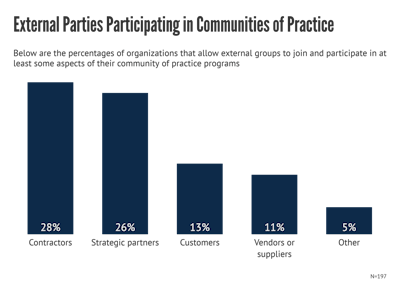
Supply chains run into problems when each link in the chain operates in its own bubble instead of collaborating with other stakeholders working on different parts of the same goal. Business silos arise for many reasons, but one of the biggest is physical and cultural distance. Teams in different parts of the world have few opportunities to connect face-to-face and build the kind of relationships that encourage open communication and sharing. Time zones and language barriers compound these disconnects, making fragmentation and miscommunication even more likely.
Getting people who never or rarely meet in person to develop meaningful collaborative relationships is tricky, but not impossible. Communities of practice—cross-functional networks designed to share information and expertise related to a topic, project, or goal—offer a way for companies to strengthen connections among colleagues and enhance the flow of knowledge across functions and locations. Although the practice is not yet mainstream, an increasing number of organizations are opening up at least some portion of their communities to external stakeholders. Communities that include partners, suppliers and customers have even greater potential to boost collaboration across the global supply chain.
Whether internal or external, most communities of practice use virtual meetings and collaboration tools like Microsoft Teams or Slack to help members in different locations share ideas, ask questions and learn from one another. However, without a strategy to promote truly global participation, communities can unintentionally leave some members feeling left out. For example, webinars may be continually scheduled at times when a certain time zone can’t attend, or members whose primary language differs from the official language of the business may struggle to converse.
The best communities of practice are able to engage members regardless of time zone, language, culture, and relationship to the organization. Based on its extensive research, member-based nonprofit APQC offers six tips to involve global players in supply chain communities and ensure all parties feel like valued participants.
1. Make global collaboration and sharing a goal. Companies that succeed at building global communities emphasize inclusiveness as a primary objective of their community programs. In fact, many discourage—or even prohibit—the creation of private or location-specific communities. This helps prevent communities from becoming their own silos and thus perpetuating the very problem they were created to overcome.
2. Make sure different regions and groups are represented on the community leadership team. If a community has a single leader, that individual—however well-intentioned—may bias planning and activities toward the preferences of his or her location or function. Organizations can prevent this by divvying up leadership duties among two or three people from different regions. This reduces the burden on each leader while helping to ensure that the community accurately reflects the needs of its members.
Communities may also consider creating regional leadership roles to promote community involvement in each location and provide local support to members. For example, agrochemical company Syngenta has made regional representation a core element of its community program. The community governance structure includes regional leads who have quarterly meetings with community leaders and the community program team to ensure ongoing engagement in different regions. In addition, each community has an informal ambassador from each manufacturing site to communicate community activities and outputs to on-site employees.
3. Keep time zones in mind when planning virtual events. It’s easy for community members to feel left out if webinars and meetings are continually scheduled in what is, for them, the middle of the night. Regional representation on community leadership teams can mitigate this problem since regional leaders can advocate for and schedule events in their own time zones.
Other strategies include regularly rotating meeting times, conducting each webinar twice at a 12-hour interval, and designing events so that they seamlessly span time zones. For example, oilfield services company Schlumberger’s communities host multi-day virtual workshops that occur continuously and “follow the sun” so that members on each continent join as their workdays begin.
4. Enable participation by second-language speakers. It’s important to recognize that the primary language of the community may be the second or third language some members speak. Organizations can make it easier for these members to participate by integrating tools like Google Translate into their community sites and platforms. Similarly, the latest webinar software can provide translated subtitles and transcripts for virtual events.
Some organizations allow local-language communities to form, but it’s important to prevent such groups from becoming their own silos. For example, at water treatment company Nalco Water, local-language communities are limited to location-specific topics. When more globally relevant questions come up, the questioner often cross-tags the query to relevant English-speaking communities. This helps facilitate knowledge sharing across language barriers and provides insight into shared challenges across the world.
5. Solicit contributions from underrepresented regions. Communities cannot reach their full potential unless every member subgroup feels empowered and motivated to share its proven practices, tips, and lessons learned. However, some may be reluctant to contribute, particularly if they see colleagues from headquarters or certain regions as the primary experts. Contributions from underrepresented locations may require additional review and polishing—especially if the authors are non-native speakers—but it is well worth the effort to gain knowledge and insight from a diverse cross-section of stakeholders.
6. Use virtual events to build relationships. Successful community programs use webinars and virtual meetings to support learning and help members forge connections. While such events are not a perfect substitute for face-to-face networking, they are an invaluable resource for globally dispersed groups. Communities can use webinars to host educational sessions run by internal and external experts, as well as to provide informal opportunities for members to share experiences and lessons from current projects.
Efficiently moving knowledge through a complex supply chain is a daunting task, and it’s easy for important details to slip through the cracks. But when correctly managed, communities of practice can enable global conversations and learning in a way that would not otherwise be possible.

















